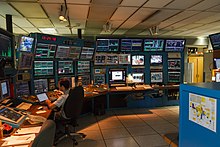This article needs additional citations for verification. (July 2011) |
49°14′52″N 123°13′50″W / 49.247792°N 123.230596°W
 | |
| Formation | 1968 |
|---|---|
| Purpose | Research and Development |
| Location |
|
| Coordinates | 49°14′52″N 123°13′50″W / 49.247792°N 123.230596°W |
Region served | Worldwide |
Staff | ~500 |
| Website | www |
 Control room of the TRIUMF main cyclotron. | |
| General properties | |
|---|---|
| Accelerator type | cyclotron |
| Beam type | proton |
| Target type | Fixed target |
| Beam properties | |
| Maximum energy | 520 MeV |
| Maximum current | 400 μA |
| Physical properties | |
| Radius | 28 feet (8.5 m) |
| Location | Vancouver, British Columbia |
| Institution | Consortium of twelve Canadian universities. |
| Dates of operation | 1974–present |
TRIUMF is Canada's national particle accelerator centre. It is considered Canada's premier physics laboratory,[1] and consistently regarded as one of the world's leading subatomic physics research centres.[2] Owned and operated by a consortium of universities, it is on the south campus of one of its founding members, the University of British Columbia in Vancouver, British Columbia, Canada. It houses the world's largest normal conducting cyclotron,[3] a source of 520 MeV protons, which was named an IEEE Milestone in 2010.[4] Its accelerator-focused activities involve particle physics, nuclear physics, nuclear medicine, materials science, and detector and accelerator development.
Over 500 scientists, engineers, technicians, tradespeople, administrative staff, postdoctoral fellows, and students work at the site. It attracts over 1000 national and international researchers every year, and has generated over $1 billion in economic activity over the last decade.
To develop TRIUMF's research priorities, physicists based at the facility and the university follow the Natural Sciences and Engineering Research Council's (NSERC) long-range plan for subatomic physics.[5] TRIUMF also has over 50 international agreements for collaborative research.[6]
Asteroid 14959 TRIUMF is named in honour of the laboratory.[7]
- ^ "2015 Budget, Chapter 3.1 – Supporting the Manufacturing Sector and Investing in Advanced Research". Government of Canada. Archived from the original on 2015-11-10. Retrieved 2016-02-14.
- ^ "An inside look at TRIUMF, the world's biggest cyclotron". Maclean's magazine. Retrieved February 9, 2016.
- ^ "Largest normal conducting cyclotron | Guinness World Records".
- ^ "List of IEEE Milestones". IEEE Global History Network. IEEE. Retrieved 4 August 2011.
- ^ "Perspectives on Subatomic Physics in Canada 2006–2016" (PDF). NSERC. Retrieved February 14, 2016.
- ^ "International Partnerships". TRIUMF. Retrieved February 14, 2016.
- ^ "Asteroid (14959) TRIUMF". RASC. 14 June 2011. Retrieved 10 June 2022.